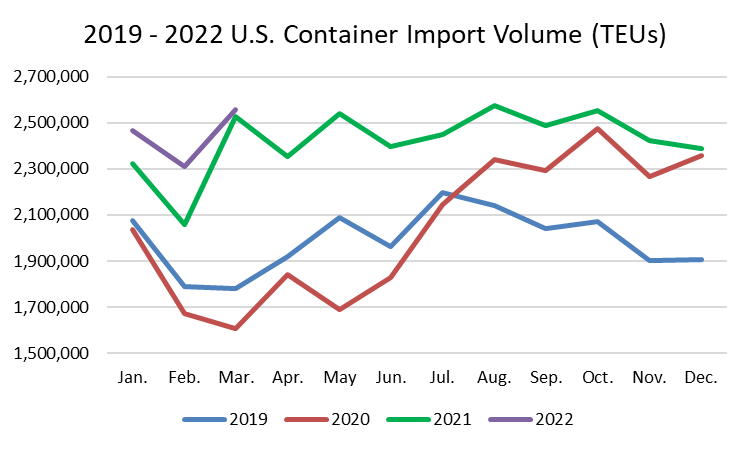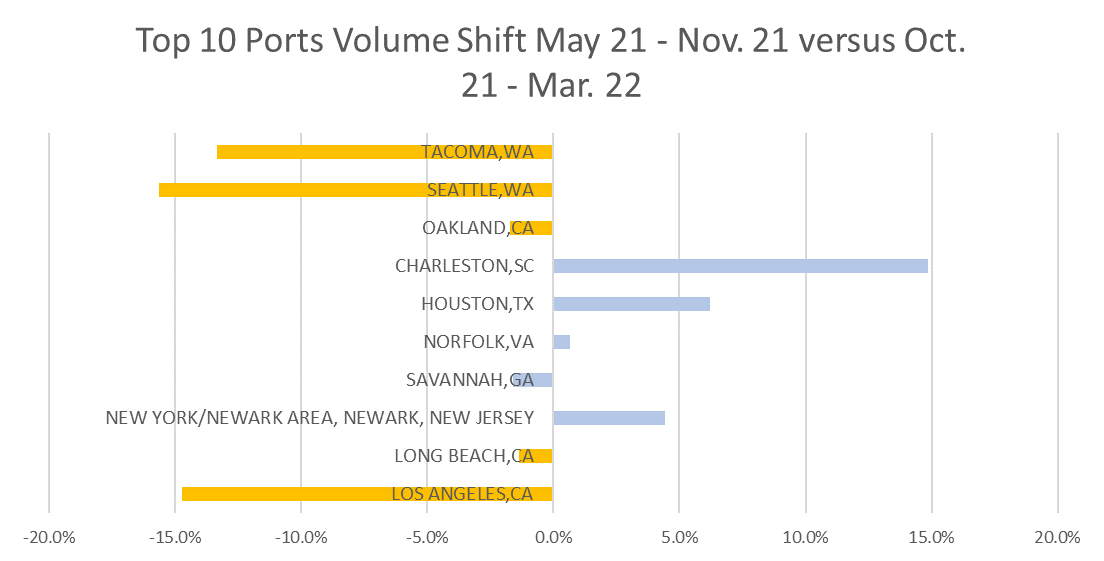Import Volumes Still at Record Levels but Port Congestion Eases

The global shipping crisis continued through March. March 2022 experienced another year-over-year record in container import volume versus 2021. COVID-related shutdowns in China continue to spread and are eclipsing the Russia/Ukraine conflict as the primary factor that could create the greatest disruption in the near future. The April update of the logistics metrics Descartes is tracking point to continued congestion and unpredictable global supply chain performance for the rest of 2022.
March continued the record monthly trend for U.S. container import volume.
March continued the very strong start to 2022 with another monthly record for U.S. container import volume (see Figure 1). Container import volumes were up 11% from February 2022 to almost 2.6 million TEUs and up 1% from March 2021 and 44% from pre-pandemic March 2019. March was also the second highest import volume in history, only eclipsed by August 2021 which falls in peak season for ocean imports.

Figure 1: U.S. Container Import Volume Year-over-Year Comparison
March U.S. container import volumes from China were down 1.4%. This is a small decrease considering that there is a 35+ day delay between the time goods set sail to the time they arrive, and that March includes the Chinese Lunar New Year period, which is traditionally soft for Chinese exports. Imports from Vietnam, India, Taiwan, South Korea and Thailand and other countries more than made up for China’s shortfall.
Is the great West to East coast shift coming to an end?
The shift of volume away from the major West Coast ports reversed itself in March 2022. Comparing the top five West Coast ports to the top five East Coast ports in March 2022 versus February 2022 shows that, of the total import container volume, East Coast ports declined to 41.4% of the total while West Coast ports represented 45.0%. In February, the split was East Coast 44.0% and West Coast 42.4%. Also interesting is the share of volume shifting away from the top 10 ports over the last 11 months. In May 2021, the top 10 ports represented 86.9% of all volume, but March 2022 was only 86.3%. Comparing five month periods as shown in Figure 2, all top West Coast ports (orange) declined in volume while all top East Coast ports (blue) increased except Savannah. The Port of Los Angeles remained in the top spot at 464,600 TEUs in March, growing ~60,000 TEUs versus February but still down from its high of 530,432 TEUs in May 2021.

Figure 2: Container Import Volume Shifts at Top 10 Ports
Improved port performance, but…
Almost across the board, ports reduced delays in March (see Figure 3). This is encouraging since U.S. import container volume was the second highest in history.
Figure 3: Top 10 Ports Monthly Average Delay (in days)
However, as long as monthly U.S. container import volumes are above 2.4M TEUs, port congestion issues will continue until infrastructure changes are made. Port congestion became a significant issue when the U.S. consistently exceeded import volumes of 2.4 million TEUs per month starting in March 2021. To put this in context, 2021 container import volume was 18% higher than 2020 and 22% higher than 2019. That is a significant volume increase for U.S. infrastructure to efficiently absorb without capital investment to improve container processing capacity at ports.
The export “roller coaster” from China is coming.
As has widely been reported, China’s “zero-COVID” policy has locked down numerous cities and ports in March. These lockdowns are likely to create a roller coaster effect on container import volumes starting in late April and beyond because of the 35+ day elapsed time for ocean crossings. While there may be short-term reprieves for U.S. ports in late April and May, Chinese manufacturing will come back online and containers stuck in China will enter the country at some point. This timing, however, could start to coincide with peak season ocean shipping, artificially making port congestion worse in the second half of the year. At a minimum, it will make logistics and inventory planning much more complicated and fraught with errors.
Another lesson learned from the Chinese lockdowns is that we are likely to experience “waves” of COVID variants travelling the world for some time to come. While new strains of the coronavirus do not appear as lethal, it’s surprisingly resilient and the impact it has on supply chain performance will continue.
Source: The Descartes Systems Group Inc

 Hellenic Shipping News Worldwide Hellenic Shipping News Worldwide, Online Daily Newspaper on Hellenic and International Shipping
Hellenic Shipping News Worldwide Hellenic Shipping News Worldwide, Online Daily Newspaper on Hellenic and International Shipping






















 PG-Software
PG-Software